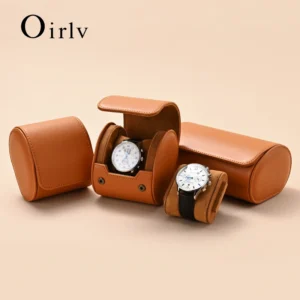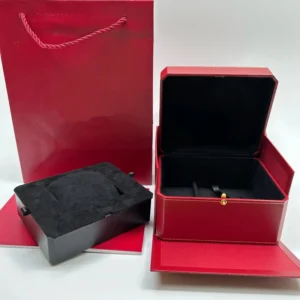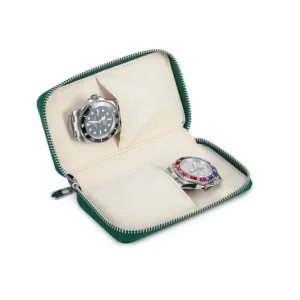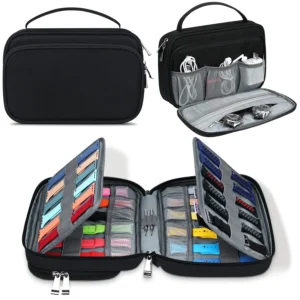Why Leather Watch Straps Need Regular Care
Yes, leather watch straps definitely need conditioning for proper maintenance, though “conditioning” is the more accurate term than “oiling.” This distinction is important because it better describes the careful nurturing these natural materials require.
Leather watch straps, much like our own skin, are natural materials that dry out over time. Without proper care, they lose essential moisture and natural oils that keep them supple and strong. Think of conditioning your leather strap similar to how you might use moisturizer on your skin—it’s about maintaining natural properties, not just adding oil.
Your leather watch strap faces daily challenges that accelerate wear:
– Body oils and sweat that can break down leather fibers
– Dirt and dust that work into the grain
– UV exposure that causes drying and fading
– Air conditioning and heating that pull moisture from the leather
When leather straps are neglected, they don’t just look worn—they develop problems that can affect comfort, appearance, and lifespan:
– Dryness that leads to cracking and splitting
– Stiffness that makes the strap uncomfortable
– Development of unpleasant odors
– Loss of color vibrancy and luster
Even high-quality leather straps from premium manufacturers require regular maintenance. The quality of the material doesn’t eliminate the need for care—it simply provides a better foundation for that care to build upon. Understanding proper leather watch case care principles applies equally to straps, as both benefit from similar conditioning approaches.
Understanding Leather Watch Strap Materials
Before discussing conditioning methods, it’s important to recognize that not all leather watch straps are created equal. The type of leather used dramatically affects how you should care for your strap.
Full-grain and top-grain leather straps are the highest quality options typically found on premium watches. These leathers retain the natural grain pattern of the hide and develop a beautiful patina over time. They respond exceptionally well to conditioning but need regular maintenance to prevent drying.
Genuine leather straps, despite the name, are actually lower quality than full-grain or top-grain. These are made from the lower layers of the hide and often have artificial grain patterns applied. They still require conditioning but may not last as long regardless of care.
Suede and nubuck watch straps have a soft, velvety texture created by raising the nap of the leather. These materials are much more absorbent than smooth leathers and require specialized care products—traditional oils can permanently damage their appearance.
Exotic leathers such as alligator, crocodile, ostrich, or stingray feature distinctive textures and patterns. Their unique scale or quill structures require gentle, specialized care to maintain their distinctive characteristics.
The tanning process—how the raw hide is converted into leather—also affects care requirements:
– Vegetable-tanned leathers (using plant materials) tend to be more receptive to natural conditioners
– Chrome-tanned leathers (using chromium salts) are typically more water-resistant but still need conditioning
Understanding how leather aging affects watch boxes and straps helps you appreciate why proper conditioning matters—it’s about preserving natural characteristics while managing the inevitable aging process.
Oils vs. Conditioners: What’s Best For Watch Straps?
When it comes to maintaining leather watch straps, terminology matters. Let’s clarify the difference between oils and conditioners to help you make the right choice.
Leather oils are penetrating lubricants that soak deeply into leather fibers. They typically contain heavier natural or synthetic oils that can over-saturate delicate watch straps, potentially causing them to become too soft or darken significantly.
Leather conditioners, on the other hand, are balanced formulations designed to moisturize without over-saturating. They often contain lighter emulsions of oils, waxes, and other ingredients that nourish leather while maintaining its structural integrity—making them generally safer for fine leather watch straps.
When people talk about “oiling” a leather watch strap, they’re usually referring to the general concept of moisturizing the leather. However, using actual oils rather than proper conditioners carries several risks:
– Excessive darkening of the leather
– Over-softening that causes stretching
– Residue that can transfer to clothing
– Potential staining of the watch itself
Here’s a comparison of common leather care products:
| Product Type | Best Uses | Potential Risks | Recommended Frequency |
|---|---|---|---|
| Oils (neatsfoot, mink) | Heavy work leathers, boots | Over-saturation, darkening | Every 6-12 months |
| Conditioners | Fine leather goods, watch straps | Minimal if used properly | Every 3-4 months |
| Balms/Creams | Combination care and protection | Can build up if over-applied | Every 2-3 months |
Quality leather conditioners suitable for watch straps include specialized products from brands like Lexol, Saphir, and Chamberlain’s Leather Milk. These products strike the right balance between nourishing the leather and maintaining its original characteristics.
When choosing products for leather care, consider the same principles that apply to cleaning products for leather watch boxes—gentle formulations designed for fine leather will preserve both appearance and durability.
Signs Your Leather Watch Strap Needs Conditioning
Recognizing when your leather strap needs attention is key to maintaining its appearance and extending its lifespan. Here are the telltale signs to watch for:
Visual indicators:
– Dull, lifeless appearance instead of a healthy sheen
– Fine surface cracks appearing, especially along bend points
– Color fading or uneven tone
– Visible dryness, particularly at the edges
– Flaking or peeling of the surface
Tactile indicators:
– Stiffness when you bend or flex the strap
– Rough, dry texture instead of smooth suppleness
– Hard or brittle feel that doesn’t soften with body heat
– Surface that feels papery or crispy rather than soft
Timeline indicators:
– Seasonal changes (particularly moving from humid summer to dry winter)
– 3-4 months have passed since last conditioning
– After exposure to unusual conditions (like getting caught in rain)
A simple test to check if your strap needs conditioning is the bend test: gently bend the strap in a U-shape. If the leather shows white stress lines or feels stiff and unyielding, it’s time for conditioning.
Environmental factors can accelerate the need for conditioning:
– Dry winter air from indoor heating
– Air conditioning that removes humidity
– Direct sunlight exposure
– Storage in very dry areas
Proper storage in quality leather watch boxes can help minimize these environmental effects, but doesn’t eliminate the need for regular conditioning. The right storage complements proper maintenance rather than replacing it.
How to Properly Condition Your Leather Watch Strap
Follow these step-by-step instructions to properly condition your leather watch strap and extend its life:
Remove the strap if possible
Removing the strap from your watch prevents any risk of conditioner getting into the watch mechanism. Use a spring bar tool to carefully detach the strap, or proceed with extra caution if you can’t remove it.Clean the strap thoroughly
Before conditioning, remove dirt, oils, and residue with a soft cloth slightly dampened with distilled water. For stubborn dirt, use a mild leather cleaner specifically designed for fine leather. Gently clean with small circular motions.Allow to dry completely
Let the strap air dry at room temperature for at least 30 minutes. Never apply heat or direct sunlight to speed drying, as this can damage the leather.Perform a spot test
Apply a tiny amount of conditioner to an inconspicuous area (like the underside near the buckle) to check for any unwanted color changes or reactions. Wait 15 minutes to observe the results.Apply conditioner properly
Place a pea-sized amount of conditioner on a clean microfiber cloth or your fingertip. Less is more—you can always add more if needed. Apply in gentle circular motions, working the product into the leather. Pay special attention to bend points and edges.Allow penetration time
Let the conditioner absorb for 10-15 minutes. The leather should absorb the product rather than having it sit on the surface.Remove excess and buff
With a clean microfiber cloth, gently buff away any excess conditioner using light, circular motions. The leather should feel soft but not greasy or sticky.Allow curing time before wearing
Let the strap rest overnight (or at least 4-6 hours) before reattaching to your watch. This gives the conditioner time to fully integrate with the leather fibers.
For application, use lint-free microfiber cloths or clean fingertips for the most control. Cotton swabs can be useful for reaching edges and buckle holes. Remember that with leather conditioning, a little goes a long way—over-conditioning can be as harmful as under-conditioning.
The techniques used for cleaning leather watch cases are similar, focusing on gentle treatment and appropriate products to maintain leather’s natural properties.
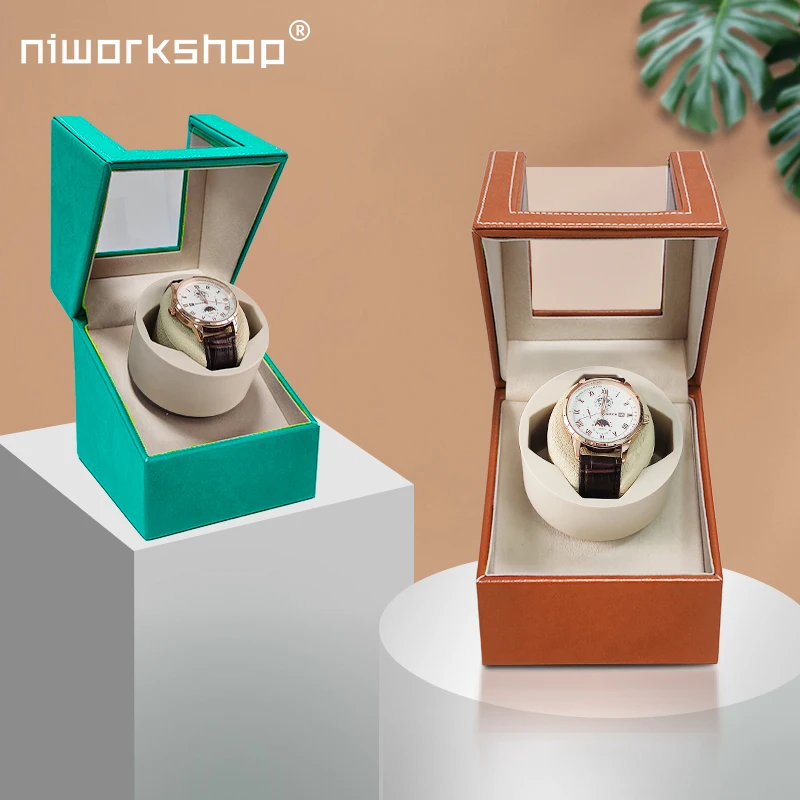
Recommended Products for Leather Watch Straps
Selecting the right products for your leather watch strap can make a significant difference in its longevity and appearance. Here are recommendations by category:
Premium Leather Conditioners:
– Saphir Renovateur: A balanced formula that nourishes without over-saturating
– Lexol Leather Conditioner: Gentle enough for fine leather with no excessive darkening
– Chamberlain’s Leather Milk: Natural-based with excellent absorption properties
– Bickmore Bick 4: Leaves minimal residue and won’t darken leather
Natural-Based Alternatives:
– Pure lanolin-based conditioners: Similar to leather’s natural oils
– Carnauba wax formulations: Provide light conditioning with protective properties
– Jojoba oil-based products: Closely resembles leather’s natural sebum
Leather Balms with Protective Waxes:
– Smith’s Leather Balm: Contains beeswax for added protection
– Venetian Shoe Cream: Subtle conditioning with light protection
– Armstrong’s All-Natural: Combines conditioning with water resistance
When selecting products, look for these beneficial ingredients:
– Lanolin (natural wool fat similar to leather’s oils)
– Beeswax (provides gentle protection)
– Jojoba oil or almond oil (light, non-greasy natural oils)
Avoid products containing these potentially harmful ingredients:
– Petroleum distillates (can dry leather over time)
– Silicones (prevent leather from breathing)
– Heavy oils like mink oil (too heavy for fine watch straps)
Watch straps require different care than heavy leather goods like boots or furniture. Products designed for fine leather goods or high-end shoes are typically most appropriate. When traveling with your watches, proper watch travel cases can help protect your leather straps from environmental extremes that accelerate drying.
How Often Should You Condition Your Watch Strap?
For most leather watch straps, conditioning 2-4 times per year provides adequate care without over-treating the leather. However, several factors can influence this frequency:
Climate and humidity:
– Dry, arid climates may require conditioning every 2-3 months
– Humid environments might need only 2 times per year
– Seasonal changes often signal good times to condition (fall and spring)
Wear patterns and exposure:
– Daily wear straps need more frequent conditioning than occasionally worn pieces
– Heavy sweating requires more frequent cleaning but not necessarily conditioning
– Outdoor exposure to sun or elements increases conditioning needs
Leather type and quality:
– Full-grain leather can often go longer between treatments
– Thinner, softer leathers may need more frequent care
– Exotic leathers like alligator typically need less frequent but more specialized care
Storage conditions:
– Straps stored in climate-controlled environments last longer between conditioning
– Extreme temperature fluctuations increase maintenance needs
– Proper storage in watch boxes reduces conditioning frequency
Watch for these signs that indicate immediate conditioning is needed:
– Noticeable stiffness when putting on the watch
– Visible dryness or small cracks forming
– Leather feels rough rather than smooth
Be careful not to over-condition your strap. Too much product can saturate the leather, making it too soft and potentially causing stretching or shape distortion. If the leather feels greasy or leaves marks on your skin or clothing, you’ve applied too much.
Establishing a simple seasonal maintenance schedule helps ensure your strap receives proper care. Many watch enthusiasts find that conditioning at the change of seasons works well as an easy-to-remember schedule. The principles outlined in our guide about wearing a leather watch every day provide additional context for maintenance frequency.
Products to Avoid on Leather Watch Straps
While proper conditioning is essential, using the wrong products can damage your leather strap beyond repair. Here are products to avoid and why they’re problematic:
Kitchen and household oils:
Olive oil, vegetable oil, and coconut oil might seem like natural alternatives, but they can turn rancid inside leather fibers, causing permanent odor and degradation. These oils never fully cure and can attract dirt.
Petroleum-based products:
Petroleum jelly, mineral oil, and baby oil might temporarily soften leather but eventually dry out the fibers and break down stitching. They can also transfer to watch cases and clothing.
Harsh cleaners and solvents:
Alcohol, ammonia-based cleaners, and acetone will strip natural oils from leather, causing severe drying and potential cracking. They can also damage dyes and finishes.
Shoe polishes:
Most shoe polishes contain waxes and dyes designed for footwear, not the more delicate leather used in watch straps. They can build up, crack, and transfer to clothing.
Silicone-based products:
While they create an initial sheen, silicone products seal the leather surface, preventing it from breathing and trapping moisture inside. This leads to deterioration from the inside out.
The consequences of using improper products extend beyond the strap itself. Oils and silicones can seep into the watch case, potentially damaging gaskets or affecting water resistance. Residue can also transfer to the dial or crystal.
For long-term protection of both your strap and watch, store them in luxury watch boxes designed to maintain appropriate humidity levels and protect from environmental factors that accelerate degradation.
Daily Care Tips for Leather Watch Straps
Beyond regular conditioning, these simple daily habits will significantly extend the life of your leather watch strap:
Proper wearing habits:
– Remove your watch before showering, swimming, or heavy exercise
– Take off your watch when washing hands and allow to dry if it gets wet
– Avoid wearing your leather strap in extreme heat or during activities with heavy sweating
– Loosen the strap slightly during hot weather to allow air circulation
Daily cleaning practices:
– Wipe the underside of your strap with a soft, dry cloth at the end of each day
– Use a slightly damp cloth to remove salt residue from sweat, then dry thoroughly
– Brush suede or nubuck straps with a dedicated soft brush to restore nap
– Allow your strap to air out completely before storing overnight
Storage recommendations:
– Store watches on a dedicated stand that doesn’t bend the strap sharply
– Keep leather straps away from direct sunlight when not being worn
– Allow air circulation around stored straps rather than sealing in airtight containers
– Maintain moderate humidity in storage areas (40-60% is ideal)
Rotation practices:
– Alternate between multiple straps to give leather time to rest and recover
– Consider seasonal rotation—lighter colors/materials for summer, darker/heavier for winter
– Keep spring bars and changing tools handy to make rotation convenient
Environmental protection:
– Apply leather protector products specifically formulated for fine leathers
– Remove watches before applying lotions, perfumes, or colognes
– Shield leather straps from rain and snow when outdoors
The same care principles that apply to protecting watches when traveling are relevant for everyday care—minimizing exposure to moisture, extreme temperatures, and physical stress will keep your leather strap looking its best.

Can You Restore a Dried-Out Leather Watch Strap?
While prevention is always better than cure, moderately dried-out leather straps can often be restored with patience and proper techniques. Here’s how to assess and potentially revive your strap:
Assessment first:
Before attempting restoration, examine your strap carefully. Restoration is possible if:
– The leather is dry but without deep cracks that go through the entire thickness
– The stitching is intact and not broken
– The attachment points are secure
– The leather bends without breaking
Gradual restoration process:
1. Start with gentle cleaning using a leather-specific cleaner
2. Apply a very small amount of conditioner, less than you’d think necessary
3. Allow it to absorb fully for 24 hours
4. Assess the improvement and repeat with another light application
5. Continue this process over several days rather than applying one heavy coat
6. Finish with a leather protectant once suppleness returns
Understand the limitations:
Not all damage can be reversed. Restoration won’t fix:
– Deep structural cracks that go through the leather
– Torn or severely stretched attachment points
– Leather that has hardened to the point of breaking when bent
– Severe discoloration or mold damage
When considering restoration versus replacement, be realistic about the condition. Sometimes a new strap is the better investment, especially if the current one might fail and risk your watch’s safety.
For valuable watches, maintaining your leather watch box with proper techniques and storing your watch correctly between wearings can prevent straps from reaching this point of severe dryness.
Luxury Watch Boxes, Men's Watch Boxes, Single Watch Box
Price range: $903.35 through $980.97 Select options This product has multiple variants. The options may be chosen on the product pageSingle Watch Travel Case, Watch and Jewelry Box, Watch Roll Travel Case
Price range: $93.44 through $140.65 Select options This product has multiple variants. The options may be chosen on the product pageLuxury Watch Boxes, Luxury Watch Travel Case
Price range: $200.33 through $224.57 Select options This product has multiple variants. The options may be chosen on the product pageLeather Watch Travel Case, Men's Watch Travel Case, Watch Roll Travel Case
Price range: $91.37 through $92.63 Select options This product has multiple variants. The options may be chosen on the product pageWatch Organizer, Watch Roll Travel Case
Price range: $88.39 through $99.36 Select options This product has multiple variants. The options may be chosen on the product pageAutomatic Watch Winder, Leather Watch Travel Case, Single Watch Winder
$146.30 Select options This product has multiple variants. The options may be chosen on the product page
Special Care for Different Leather Types
Different types of leather require specific approaches to care and conditioning. Here’s how to adapt your methods for common watch strap materials:
Full-grain and top-grain leather:
– Can handle traditional leather conditioners
– Responds well to lanolin or beeswax-based products
– Benefits from light, frequent conditioning rather than heavy, infrequent treatments
– Develops natural patina that shouldn’t be scrubbed away
– Allow 1-2 weeks of wear before first conditioning new straps
Suede and nubuck:
– Never use oils or traditional conditioners—they will permanently mat the nap
– Use only specialized suede/nubuck products that maintain the texture
– Clean with a dedicated suede brush to restore nap
– Apply suede protector spray to guard against staining
– Handle with clean hands to prevent oils from transferring
Exotic leathers (alligator, ostrich, etc.):
– Require specialized conditioners designed for their unique structures
– Need gentle application that respects scale patterns or quill dimples
– Benefit from products containing lanolin and natural waxes
– Often need less frequent conditioning than standard leathers
– Should be stored flat to prevent scale deformation
Patent leather:
– Avoid all oils and traditional conditioners
– Clean only with products specifically for patent leather
– Use a soft cloth with specialized patent leather restorer for shine
– Protect from direct sunlight which can cause cracking
– Store with tissue between folded sections to prevent sticking
Vegetable-tanned vs. chrome-tanned:
– Vegetable-tanned leather absorbs conditioner more readily and may darken more
– Chrome-tanned leather is more resistant to water but still needs conditioning
– Vegetable-tanned responds better to natural conditioners
– Chrome-tanned may benefit from synthetic blends with UV protection
For any specialty leather, test products on an inconspicuous spot first. The quality features that make premium leather watch boxes desirable—careful material selection and proper finishing—also apply to high-quality watch straps and influence how they should be maintained.
Watch Strap Discoloration: Prevention and Solutions
Discoloration is one of the most common concerns when conditioning leather watch straps. Understanding the causes and solutions helps you maintain your strap’s original appearance.
Common causes of discoloration:
– Oils from skin accumulating on the surface
– UV exposure causing fading or darkening
– Improper conditioners that penetrate unevenly
– Sweat interacting with leather tannins
– Dye transfer from clothing or other materials
Proper conditioning actually prevents most types of discoloration by maintaining the leather’s protective finish. When leather dries out, it becomes more absorbent and prone to staining from oils and sweat.
For existing discoloration:
– Light stains may respond to gentle cleaning with leather-specific cleaner
– Darkened areas from over-conditioning may lighten over time with regular wear
– Uneven coloration can sometimes be balanced with proper conditioning
– Severe discoloration may require professional restoration or replacement
It’s important to understand that some darkening when applying conditioner is normal and expected. Quality leather typically darkens slightly when conditioned but returns close to its original color as the conditioner is fully absorbed. This is different from problematic staining or discoloration.
To minimize color changes:
– Always test products on an inconspicuous area first
– Use neutral, non-darkening conditioners designed for fine leather
– Apply thin, even coats rather than heavy applications
– Allow full absorption between applications
– Protect leather from excessive UV exposure
Understanding how to protect leather accessories from moisture also helps prevent water stains and related discoloration that can occur when leather gets wet and dries improperly.

Common Questions About Leather Watch Strap Care
Will conditioning darken my leather strap?
Most conditioners will temporarily darken leather slightly, but quality products allow the leather to return close to its original color once fully absorbed. Always test on an inconspicuous spot first, and use products specifically stating “non-darkening” if this is a concern.
Can I use household items instead of leather-specific products?
While some household items like lanolin (from wool) can work in emergencies, most household substitutes (olive oil, petroleum jelly, etc.) will damage leather over time. Professional leather care products are formulated specifically to maintain leather’s properties without unwanted side effects.
How do I remove odors from my leather strap?
For mild odors, air out the strap in a well-ventilated area away from direct sunlight. For persistent smells, wipe with a cloth slightly dampened with a 50/50 mix of distilled water and white vinegar, then allow to dry completely before conditioning. Baking soda can absorb odors if placed near (not on) the leather overnight.
Is waterproofing leather watch straps possible?
Leather can be made more water-resistant but never truly waterproof. Specialized leather protectors create a barrier against light moisture but won’t withstand submersion. These products generally work best on full-grain leather and may change the appearance slightly.
Can vintage watch straps be conditioned?
Yes, but with extra caution. Vintage leather is often more delicate and may have specialized dyes or finishes. Start with very small amounts of conditioner, and work gradually. Some vintage collectors prefer to leave patina undisturbed rather than restoring suppleness.
How can I clean between the stitching on my leather strap?
Use a soft-bristled toothbrush or cotton swab to gently clean between stitches. Be careful not to apply too much pressure that could damage the stitching. A small amount of leather cleaner on the brush helps remove embedded dirt.
Is It Time to Replace Your Leather Watch Strap?
Even with proper care, leather watch straps have a finite lifespan. Here are signs that indicate replacement might be necessary:
Structural damage:
– Cracks that go through the entire thickness of the leather
– Tearing around spring bar attachment points
– Holes that have stretched and deformed
– Layers of leather separating or delaminating
Stitching problems:
– Multiple broken stitches that affect structural integrity
– Unraveling thread that can’t be repaired
– Stitching pulling through the leather
Persistent issues:
– Odors that remain despite cleaning and airing out
– Stiffness that doesn’t improve with conditioning
– Discoloration that affects appearance significantly
Deformation:
– Excessive stretching that makes proper fit impossible
– Permanent creases or folds that weaken the structure
– Twisted shape that doesn’t sit properly on the wrist
The average lifespan of leather watch straps varies significantly based on quality and use:
– Daily-wear straps of moderate quality: 6-12 months
– High-quality straps with regular care: 1-3 years
– Premium exotic leather with excellent care: 3-5+ years
– Occasionally worn straps: Significantly longer with proper storage
When deciding between restoration and replacement, consider the watch’s value and your attachment to the current strap. For valuable timepieces, investing in a new quality strap is often the better choice than risking damage from a failing strap.
Quality replacement straps can renew the look of your entire watch and provide another opportunity to experience that perfect combination of comfort and style that only a well-made leather strap can offer.



